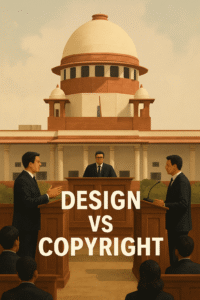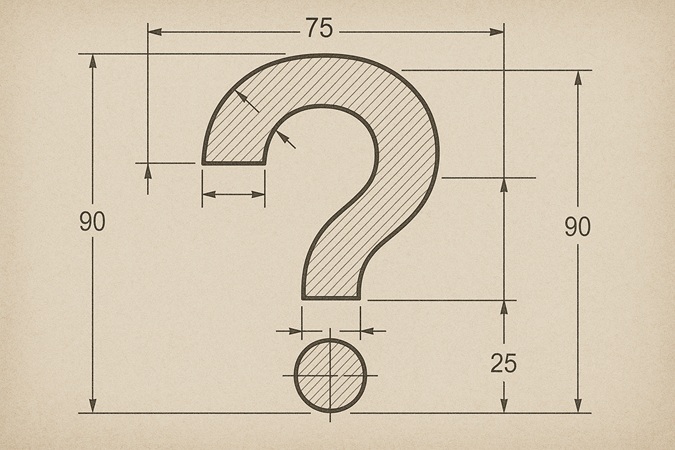Copyright vs. Design Law: The Definitive Ruling on Engineering Drawings in Commercial Manufacturing
For years, the overlap between copyright and design protection has raised challenging questions in Indian intellectual property law, especially when it comes to engineering drawings used in industrial manufacturing. Can a company claim copyright in a technical drawing once that design becomes part of a manufactured product? Or must protection be sought under the Designs Act alone?
In a landmark judgment, Cryogas Equipment Pvt. Ltd. & LNG Express India Pvt. Ltd. v. Inox India Ltd., the Supreme Court of India has brought long-awaited clarity to this legal grey area. The Court didn’t just weigh in on the issue; it laid down a clear two-pronged test to help courts and stakeholders distinguish when copyright applies, and when design law takes over.
This decision marks a turning point for industries that depend on proprietary design work, from manufacturing and engineering to industrial design, offering much-needed guidance on how their creative assets are protected under Indian IP law.
Core legal issue: When do engineering drawings stop being copyrightable artistic works and start being unprotected industrial designs?
Inox India Ltd., a long-time manufacturer of cryogenic storage and transport tanks, claimed copyright over its proprietary technical drawings, developed through years of research and strengthened by its 2009 acquisition of U.S.-based CVA. According to Inox, these drawings, along with supporting textual material, were original “artistic works” under Section 2(c) of the Copyright Act, 1957.
The dispute flared up in August 2018, when Inox discovered that Cryogas Equipment Pvt. Ltd. had entered the LNG trailer market and submitted drawings for PESO approval that allegedly copied Inox’s, even replicating the same spelling errors. Inox accused Cryogas of copyright infringement and misuse of confidential information.
The defendants pushed back, arguing that the drawings weren’t artistic works at all, but unregistered “designs” under the Designs Act, 2000. And since these designs had allegedly been commercially applied more than 50 times, they claimed that copyright protection had automatically lapsed under Section 15(2) of the Copyright Act.
Initial Court Proceedings and Appeal
Inox India Ltd. filed a suit in 2018, seeking an interim injunction to stop Cryogas Equipment Pvt. Ltd., LNG Express India Pvt. Ltd., and others from infringing on its intellectual property rights and confidential information during the ongoing case. In response, LNG Express sought to dismiss the suit, arguing it was not maintainable under Section 15(2) of the Copyright Act, 1957, claiming that copyright protection ceased after a certain number of industrial applications of the design.
The Commercial Court at Vadodara agreed with LNG Express and rejected Inox’s injunction request, dismissing the suit. Inox then appealed to the Gujarat High Court. The High Court set aside the Commercial Court’s decision, finding that it had wrongly dismissed the case without a full hearing. It sent the matter back for reconsideration.
On reconsideration, the Commercial Court again rejected Inox’s suit and injunction request. Inox appealed once more to the High Court. This time, the Gujarat High Court ruled in Inox’s favor. It found that the Commercial Court had wrongly assumed Inox’s engineering drawings were merely “designs” under the Designs Act and therefore not eligible for copyright protection. The High Court reinstated Inox’s suit and injunction request and directed the Commercial Court to decide the injunction application on its merits within eight weeks, emphasizing that the case involved complex factual and legal questions requiring a full trial. Cryogas and LNG Express (“Appellants”) then appealed to the Supreme Court.

Supreme Court’s Verdict: Defining Line Between Copyright and Design
The primary argument presented by the learned counsel for the Appellants was that Inox’s suit was barred under Section 15(2) of the Copyright Act. They contended that the intellectual properties for which Inox claimed copyright infringement were eligible for registration under the Designs Act. According to Section 15(2) of the Copyright Act, copyright protection in such drawings ceases once the semi-trailers have been reproduced or manufactured more than fifty times through an industrial process.
Conversely, the counsel for Inox argued that the suit involved two distinct categories of intellectual property: the proprietary engineering drawings and the literary works, each requiring independent adjudication. They maintained that the drawings fall within the scope of Section 2(c) of the Copyright Act, which defines “artistic work,” and that these drawings cannot be registered as designs under the Designs Act. Additionally, the literary works in question are not subject to the restrictions imposed by Section 15(2) of the Copyright Act.
The key issues before the Hon’ble Supreme Court were:
- What criteria should be used to determine whether an artistic work or article falls within the limitation set by Section 15(2) of the Copyright Act, thereby classifying it as a “design” under Section 2(d) of the Designs Act?
- Whether the High Court erred in overturning the Commercial Court’s order and rejecting the application under Order VII Rule 11 of the CPC?
To address these, the Supreme Court developed a two-pronged test to determine whether an artistic work is entitled to copyright protection under the Copyright Act, 1957, or falls exclusively under the purview of design law. The Court outlined the following considerations:
- Artistic Work vs. Industrial Design: First, the court must determine if the work is purely artistic (protected by copyright) or has been industrially applied, in which case design law applies. If the design has been produced more than fifty times, copyright protection ends unless the design is registered under the Designs Act.
- Functional Utility Test: Even if artistic elements exist, the court must assess the work’s primary purpose. If the design is mainly aesthetic, it may qualify for design protection. But if it serves a functional or mechanical purpose, it may fall outside the Designs Act altogether.
In reaching its conclusion, the Supreme Court carefully reviewed relevant Indian and international jurisprudence, including key precedents that shed light on the delicate balance between copyright and design protection.
- Microfibres Inc. v. Girdhar & Co. (Delhi High Court), where it was held that copyright protection is not available for textile patterns that are capable of being registered under the Designs Act and have been applied industrially. The Court emphasized that artistic works used in mass production lose their copyright once they cross the fifty-unit threshold under Section 15(2).
- Dart Industries Inc. v. Techno Plast, where the Delhi High Court held that product drawings, even if artistic in origin, cannot claim copyright protection if their primary purpose is industrial manufacture.
Internationally, the Court referred to American jurisprudence such Amp v. Utilux, wherein the question of ‘functional utility’ in the context of design was first addressed by the House of Lords. Importantly this decision was the first to draw a distinction in designs between ‘features’ and ‘shapes’ that were construed to be ‘aesthetically appealing’ to the eye of the consumer, in comparison to features that existed merely for ‘purely functional purposes. The court also referred to Mazer v. Stein and Star Athletica v. Varsity Brands, where U.S. courts developed the doctrine of conceptual separability, a principle similar to the functional utility test. This doctrine helps determine when a work’s artistic elements can be separated from its utilitarian function, thus clarifying its eligibility for copyright. This line of distinction on the basis of features being eye-appealing or merely due to functional utility, as developed by English courts, has been subsequently employed by some of the High courts in India.
- For functional utility test, the Court relied on cases like Smithkline Beecham Plc. v. Hindustan Lever Ltd and Tractors and Farm Equipment Ltd. v. Standard Combines Pvt. Ltd.
While the Supreme Court refrained from conclusively deciding whether the engineering drawings qualified as copyrightable works or registrable designs, it held that such determinations require a full trial. The Court found the Commercial Court’s dismissal of the plaint at the preliminary stage, without conducting this inquiry, to be erroneous. It accordingly directed the Commercial Court to consider the interim injunction application on its merits, guided by the broad parameters it established to clarify the complex intersection of copyright and design law.
Key takeaways:
- Section 15(2) of the Copyright Act mandates a detailed inquiry to determine if a drawing falls under the Designs Act, preventing outright dismissal of a suit under Order VII Rule 11(d) based solely on plaint averments.
- The core dispute is whether the ‘Proprietary Engineering Drawings’ qualify as “artistic works” under Section 2(c) of the Copyright Act or as “designs” under Section 2(d) of the Designs Act, requiring detailed examination.
- Under Order VII Rule 11(a) of the CPC, a plaint can be rejected only if it fails to disclose a cause of action; since the plaintiff clearly claimed copyright protection over the Proprietary Engineering Drawings and related know-how, rejection of the plaint was unwarranted.
- The suit includes claims beyond copyright infringement, such as literary work, confidential information, and know-how, which cannot be partially rejected; therefore, the entire suit must proceed to trial.
Significance of the Verdict
The Supreme Court’s decision provides much-needed clarity on a complex and often ambiguous area of intellectual property law, namely, the intersection of copyright and design protection, particularly in light of the 50-copy rule. By establishing a clear two-pronged test, the Court has equipped judges and practitioners with a practical framework to navigate disputes involving overlapping claims of copyright and design rights.
For industry stakeholders, the ruling underscores the importance of choosing the appropriate form of protection based on the nature and intended use of their creations. Where a design has significant aesthetic value and is intended for mass production, securing registration under the Designs Act is crucial, as copyright protection for drawings or artistic works can cease once production exceeds fifty units. Conversely, creators of purely artistic works must be mindful of the statutory limit—exceeding fifty reproductions without design registration can result in the loss of exclusive copyright protection, effectively placing the work in the public domain from a copyright perspective.
This judgment strikes a careful balance: it encourages genuine artistic creativity by granting robust copyright protection while ensuring that industrial designs, once mass-produced, are appropriately regulated to eventually enter the public domain unless formally registered. In resolving the longstanding tension between copyright and design law, the Supreme Court has drawn a definitive boundary, providing much-needed certainty and guidance for creators, manufacturers, and legal professionals alike.
Subsequent developments:
In conclusion, the Commercial Court, following the Supreme Court’s directive, recognized that Inox’s proprietary engineering drawings qualify as both artistic and literary works protected under the Copyright Act. Rejecting Cryogas’s preliminary challenge under Section 15(2), the Court emphasized the functional nature of the technology over mere aesthetic design and underscored the independent intellectual effort involved in creating the drawings. While reserving final judgment for trial, the Court granted interim protection to Inox, affirming jurisdiction over the combined claims and safeguarding Inox’s rights against alleged infringement, misuse, and irreparable harm.
Below is a quick overview of the different types of Intellectual Property and how each is protected.
| Sr. No | Type of Intellectual Property | Protect Under |
| 1 | Photograph | Copyright |
| 2 | Blueprints (after 50 Copies) | |
| With Aesthetic appeal | Design | |
| Without Aesthetic appeal | Copyright | |
| 3 | 2D Engineering Drawing | Copyright |
| 4 | 2D CAD Drawing | Copyright |
| 5 | CAD realistic three-dimensional models | Design |
| 6 | Assembly Drawings | Copyright |
| 7 | Cross-sectional Drawings | Copyright |
| 8 | Process Engineering Diagrams / Process Flow Diagrams (PFDs) | Copyright |
| 9 | Architectural / Civil Engineering Drawings | Copyright |
| 10 | 3D cartographical didactic materials | Copyright |
Case number: C.A. No.-005174-005174 – 2025 (Cryogas Equipment Pvt. Ltd. vs. Inox India Ltd. and Ors.)


